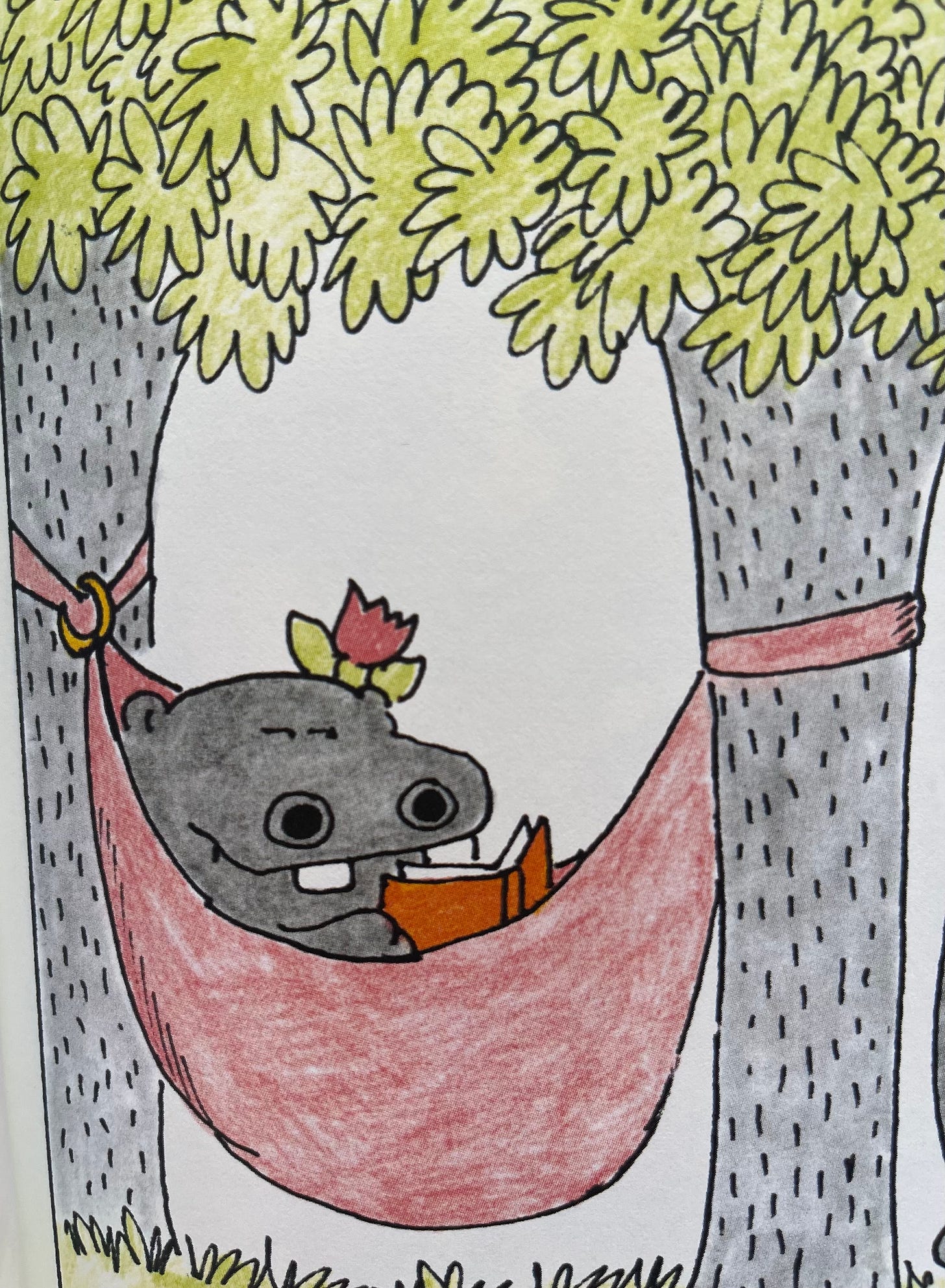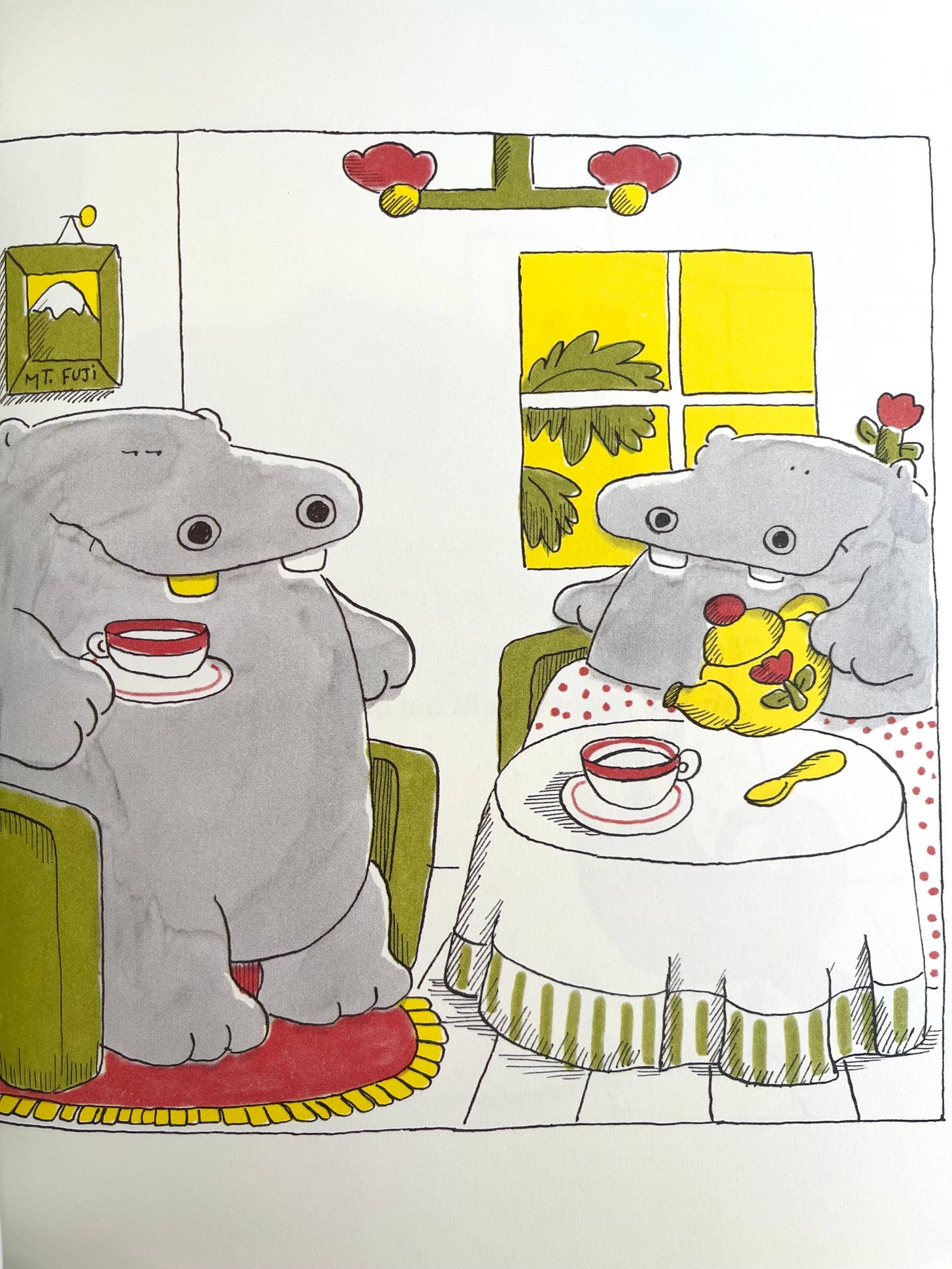Stop and Smell the Tulips
Alternate title: "James and the Giant Tulip." Alternate of the alternate title: "My Favorite Spring Children's Story" (A lackluster title that'd probably get more clicks than me trying to be cute.)
Ask any James Marshall fan what their favorite George and Martha story is, and you’ll receive a quick, enthusiastic answer. Often it’s “Split Pea Soup” or “The Surprise” — both of which are charming and hilarious (a Marshall specialty), but neither is my favorite. The story that planted a seed in my heart is “The Garden,” the last story in George and Martha: Encore.
“The Garden” starts with Martha feeling discouraged about her messy weed garden. “I don’t seem to have a green thumb,” she sobbed. (Who can relate?!) Being the good friend that he is, George comes up with the absurd but ingenious idea to “plant” store-bought tulips (Martha’s favorite flower) in her unsightly garden. While George is sneakily sticking the tulips into the ground, Martha spots him, but the surprise isn’t ruined, at least not for Martha. She knows George’s thoughtful act isn’t really about the garden. How could it be? Those tulips are going to die by the end of the day! This is about friendship, and Martha kindly assuages George’s disappointment.
“Dear George.” she said.
“I would much rather have a friend like you than all the gardens in the world.”
Typically a George and Martha story ends with one of them getting the upper hand, usually after one’s played a sneaky trick on the other, but in this story, the sneaky trick’s flipped on its head: it’s warmhearted. This is the brilliance of James Marshall. In four short spreads, he can make us laugh and cry without a hint of cloying sentimentality.
The first George and Martha book came out in 1972 and was Marshall’s debut as an author and illustrator. His first book, Plink, Plink, Plink (1971), written by Bryd Baylor, wasn’t well-received, especially by Marshall. He felt embarrassed by what he considered the “awful poems and awful pictures” (k-faisteele.com). Looking at Marshall’s early drawings, he seems unsure of his style. The heavily textured crosshatched illustrations resemble a blend of two of his favorite contemporaries: Edward Gorey and Maurice Sendak. But it didn’t take long for Marshall’s genius to emerge. On a warm, sunny Texas afternoon, while Marshall was drawing and relaxing in a hammock, his mother was in the house watching Who’s Afraid of Virginia Woolf (1966) on TV. And the loud, cantankerous banter of the movie’s notoriously dysfunctional couple, George and Martha, reverberated inside Marshall’s imagination and inspired our favorite devious but fun-loving hippos.
Maurice Sendak’s touching foreword for George and Martha: The Complete Stories of Two Best Friends (1997) vividly describes Marshall’s work as “undated, fresh and fragrant as a new spring garden.” Even now, twenty-five years later, I mostly agree with Sendak. However, aspects of Marshall’s books feel dated for modern times (many of his books lack diversity and social consciousness). Despite his blindspots, Marshall had good intentions.
It’s easy to talk about Marshall’s humor and charm, but it’s difficult to articulate his elegance and thoughtful consideration for children’s books. Yet the more you engage with his work, the more you’ll recognize his attention to detail. At first glance, Marshall’s illustrations appear simple; most of his characters only have tiny dots as eyes —his work looks easy to replicate — but looks can be deceiving. On close inspection, you’ll recognize his lush artistry.
Marshall loved sneaking clues into his books — often subtlety placed on book covers, posters, and clothing. He repeatedly included images of his home state, Texas. Once, to my family’s delight, he had a postcard of Santa Cruz in Goldie Locks and the Three Bears (1988). But the details I notice most are the flowers. There are flowers on tablecloths, rugs, trashcans, wallpaper, and (naturally) in gardens. Flowers are everywhere! Especially the tulip, which Martha always wears tucked cutely behind one ear. Tulips show up so often in Marshall’s work I was convinced there’d be articles about it — surely someone’s mentioned it’s his favorite flower. But nothing came up. Actually, there was hardly anything about his flowers or his work in general. Which reinforced my thinking: the average Marshall reader is not paying attention.
Now, more than ever, we need to pay close attention, not only to art and nature but to each other. Luckily, spring is the perfect season to stop and smell the tulips. Let’s be like Martha and force a lazy friend to go on a picnic, or like George and help spruce up a friend’s unsightly garden. If there’s anything to learn from Marshall’s books, it’s that life can be hard, scary, and strange, but it’s better with the tenderness and humor of a good friend.
The Marshall Tulip
The Guest (1975)
George and Martha: Rise and Shine - “The Fibber” (1979)
Space Case (1980)
Getting to know James Marshall (a little bit)
James Marshall illustrated more than 70 books (he also wrote many of them — sometimes using the pseudonym Edward Marshall). In 1992, at the age of 50, he died from AIDS.
Video c/o Paul Gagne of Weston Woods
A Tribute
“Martha in her yellow robe” by Elodie, age 8
Here’s a spontaneous, little interview I had with my eight-year-old daughter, Elodie, who never stops drawing. She mentions drawing dots — which feels like a cute, unexpected tribute to Marshall. Oh, and those loud noises in the background? That’s my five-year-old son raucously playing with toy dinosaurs in the shower. Such professionalism!
Where are the book recommendations?!
If you’ve made it this far into my newsletter, it’s likely because you’ve quickly scrolled to the end to see if I’m ever going to recommend spring books. If you have read the entire thing — WOW! You get a gold star. But unfortunately, this newsletter is on the verge of being too long; I’ll save detailed recommendations for another time.
However, I do have past recommendations on my website:
9 Kids’ Books for Spring (2021)
12 Picture Books for Summer (2021)
Here are a few new-ish releases I’m excited about:
Nigel and the Moon written by Antwan Eady and illustrated by Gracey Zang (2022)
On the Day the Horse Got Out by Audrey Helen Weber (2021)
Otto: A Palindrama by Jon Agee (2021)
The Bath House written by Kayo Maclear and illustrated by Gracey Zang (2021)
Emile and the Field written by Kevin Young and illustrated by Chioma Ebinama (2022)
The First Cat In Space Ate Pizza written by Mac Barnett and illustrated by Shawn Harris (May 2022). We can’t wait for this one to come out! Watch the Live Cartoons!
I’ve added books to my Bookshop.org page:
There are also AMAZING book recommendations on the first Moonbow discussion board — join in:
Last but not least!
Thank you for reading this newsletter. It means a lot to me. I’ve created free content for over thirteen years, and while I still plan for Moonbow to be mostly free, I am adding a paid subscription option. These take a lot of time and research to make. If you've enjoyed it and are looking forward to reading more, please consider a paid subscription (think of it as a donation). You can set up payments to be monthly, yearly, or become a founding member. I’ll create fun extras for paid subscribers (like merch!).













Continuing to catch up with your writing. :) Loving your posts. And, naturally, I'm finding myself gravitating towards your James Marshall posts.
I addressed this topic, Marshall's use of stereotypes, a few weeks ago. The subject had been hanging over my head since starting work on his biography so I finally wanted to put my thoughts into writing.
And talk about "too cute" titles... you can see my first draft title in the blog post url (to the tune of DEEP IN THE HEART OF TEXAS):
https://jerroldconnors.com/2023/03/24/the-hippos-wear-feathers-in-their-hair-clap-clap-clap-clap-deep-in-the-heart-of-texas/